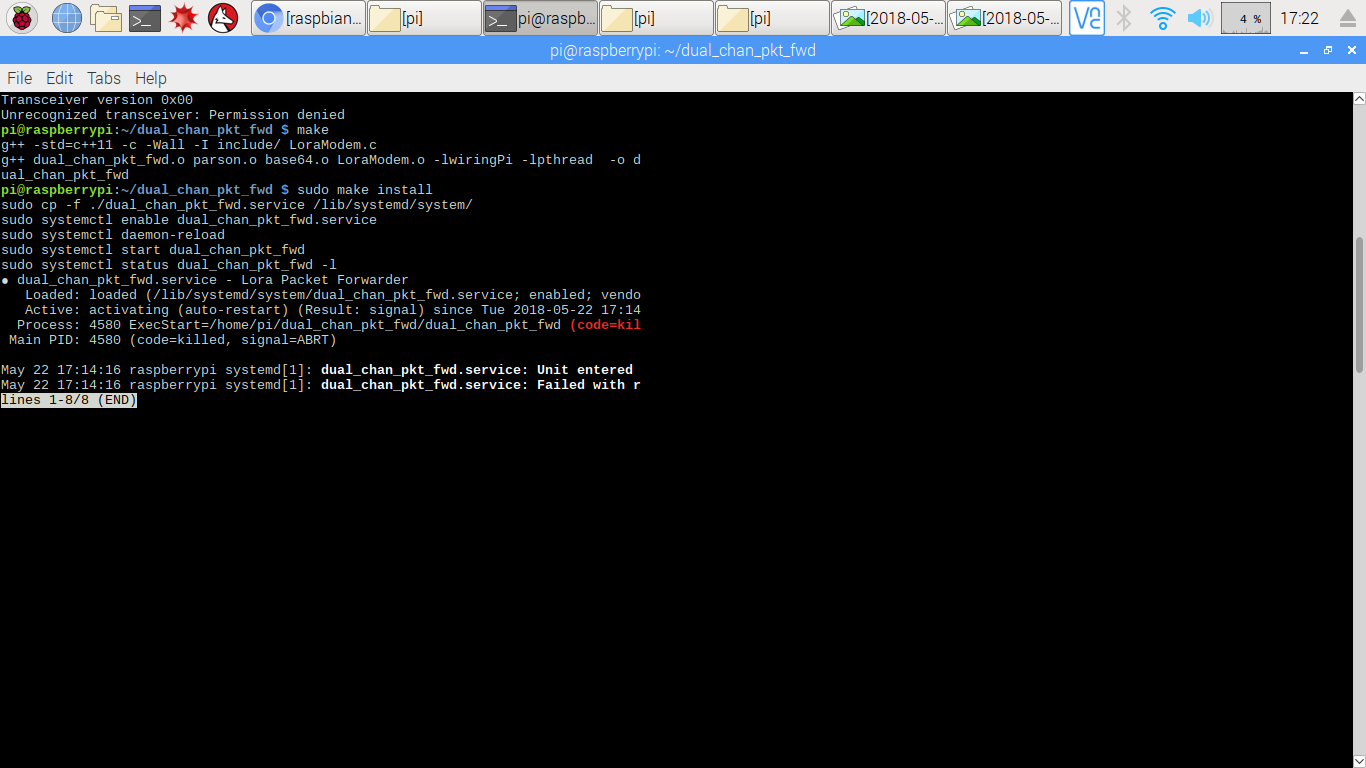Hi
these are the sensor and gateway logs when I did the tests
OUTPUT SERIAL ATOM HELTEC32 con ricezione DownStream message
10101683: engineUpdate, opmode=0x908
10101731: TXMODE, freq=868100000, len=23, SF=7, BW=125, CR=4/5, IH=0
Packet queued
10161952: RXMODE_SINGLE, freq=868100000, SF=7, BW=125, CR=4/5, IH=0
10218564: RXMODE_SINGLE, freq=869525000, SF=9, BW=125, CR=4/5, IH=0
10244705: EV_TXCOMPLETE (includes waiting for RX windows)
bytes of payload: 0x
10244710: engineUpdate, opmode=0x900
12119710: engineUpdate, opmode=0x908
12119758: TXMODE, freq=868100000, len=23, SF=7, BW=125, CR=4/5, IH=0
Packet queued
12179979: RXMODE_SINGLE, freq=868100000, SF=7, BW=125, CR=4/5, IH=0
12189361: Received downlink, window=RX1, port=1, ack=0
12189371: EV_TXCOMPLETE (includes waiting for RX windows)
Received
3
bytes of payload
bytes of payload: 0x000102
12189632: engineUpdate, opmode=0x800
14064632: engineUpdate, opmode=0x808
14064680: TXMODE, freq=868100000, len=23, SF=7, BW=125, CR=4/5, IH=0
Packet queued
14124902: RXMODE_SINGLE, freq=868100000, SF=7, BW=125, CR=4/5, IH=0
14181513: RXMODE_SINGLE, freq=869525000, SF=9, BW=125, CR=4/5, IH=0
14207650: EV_TXCOMPLETE (includes waiting for RX windows)
bytes of payload: 0x
14207655: engineUpdate, opmode=0x900
OUTPUT GATEWAY01 con ricezione Downstream message
stat update: 2018-03-27 20:46:03 GMT 5 packets received, 0 packet sent…
CE0 Packet RSSI: -36, RSSI: -104, SNR: 9, Length: 23 Message:rxpk update: {“rxpk”:[{“tmst”:4212123479,“freq”:868.3,“chan”:0,“rfch”:0,“stat”:1,“modu”:“LORA”,“datr”:“SF7BW125”,“codr”:“4/5”,“rssi”:-36,“lsnr”:9.0,“size”:23,“data”:“QFsRASaAAwABjDJ01tnrMyOjfhbubvA=”}]}
stat update: 2018-03-27 20:46:33 GMT 6 packets received, 0 packet sent…
CE0 Packet RSSI: -47, RSSI: -97, SNR: 9, Length: 23 Message:rxpk update: {“rxpk”:[{“tmst”:4244415677,“freq”:868.3,“chan”:0,“rfch”:0,“stat”:1,“modu”:“LORA”,“datr”:“SF7BW125”,“codr”:“4/5”,“rssi”:-47,“lsnr”:9.0,“size”:23,“data”:“QFsRASaABAAB0bMQfYyQzR9XHc114hM=”}]}
stat update: 2018-03-27 20:47:03 GMT 7 packets received, 0 packet sent…
CE0 Packet RSSI: -45, RSSI: -100, SNR: 9, Length: 23 Message:rxpk update: {“rxpk”:[{“tmst”:4276705521,“freq”:868.3,“chan”:0,“rfch”:0,“stat”:1,“modu”:“LORA”,“datr”:“SF7BW125”,“codr”:“4/5”,“rssi”:-45,“lsnr”:9.0,“size”:23,“data”:“QFsRASaABQABBcRMhLqXGcj8QZNlTIY=”}]}
stat update: 2018-03-27 20:47:33 GMT 8 packets received, 0 packet sent…
CE0 Packet RSSI: -43, RSSI: -97, SNR: 8, Length: 23 Message:rxpk update: {“rxpk”:[{“tmst”:14027286,“freq”:868.3,“chan”:0,“rfch”:0,“stat”:1,“modu”:“LORA”,“datr”:“SF7BW125”,“codr”:“4/5”,“rssi”:-43,“lsnr”:8.0,“size”:23,“data”:“QFsRASaABgABT7eMr79xFNcu5Yl4iE0=”}]}
Sending packet:: tmst=15027286, wait= -1507156382, strict=0, datr=SF7BW125, freq=868300000->868300000, sf=7->7, modu=LORA, powe=14, codr=4/5, ipol=1, through CE1.
PKT_PULL_RESP:: From server router.eu.staging.thethings.network.
stat update: 2018-03-27 20:48:03 GMT 9 packets received, 1 packet sent…
CE0 Packet RSSI: -43, RSSI: -97, SNR: 9, Length: 23 Message:rxpk update: {“rxpk”:[{“tmst”:45146368,“freq”:868.3,“chan”:0,“rfch”:0,“stat”:1,“modu”:“LORA”,“datr”:“SF7BW125”,“codr”:“4/5”,“rssi”:-43,“lsnr”:9.0,“size”:23,“data”:“QFsRASaABwABXd/KTwbnvgAmhUtl0wY=”}]}
stat update: 2018-03-27 20:48:33 GMT 10 packets received, 1 packet sent…



 !
!